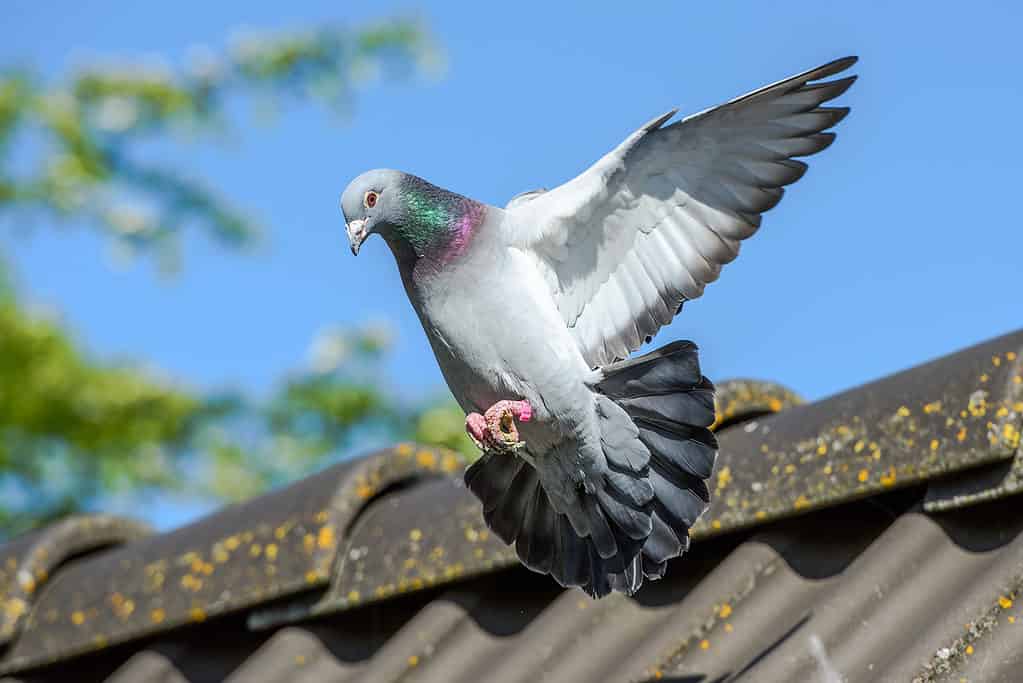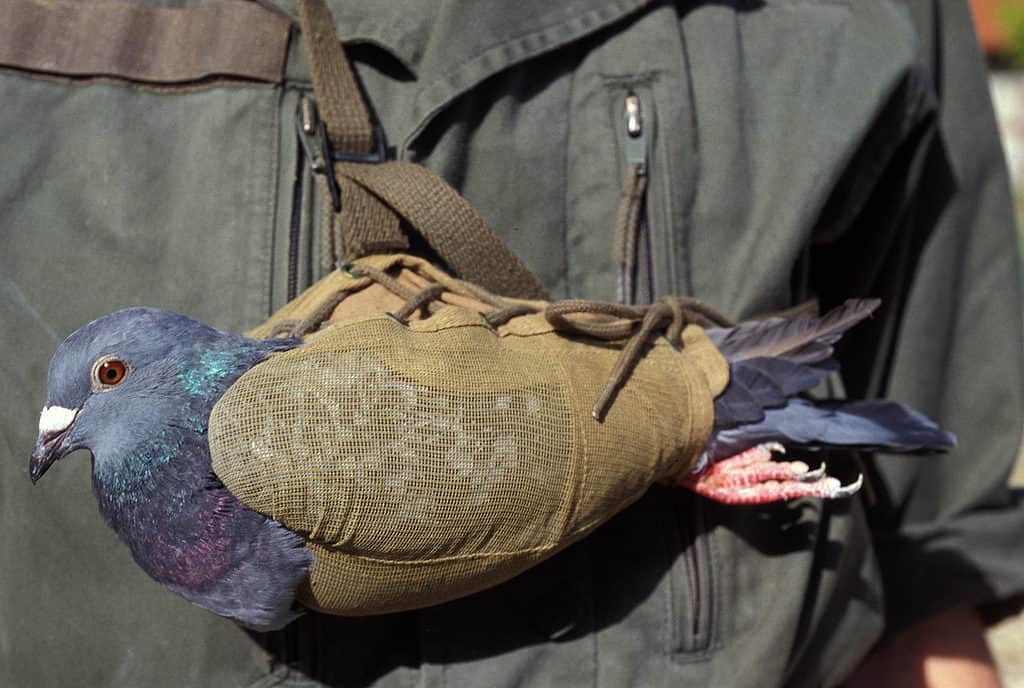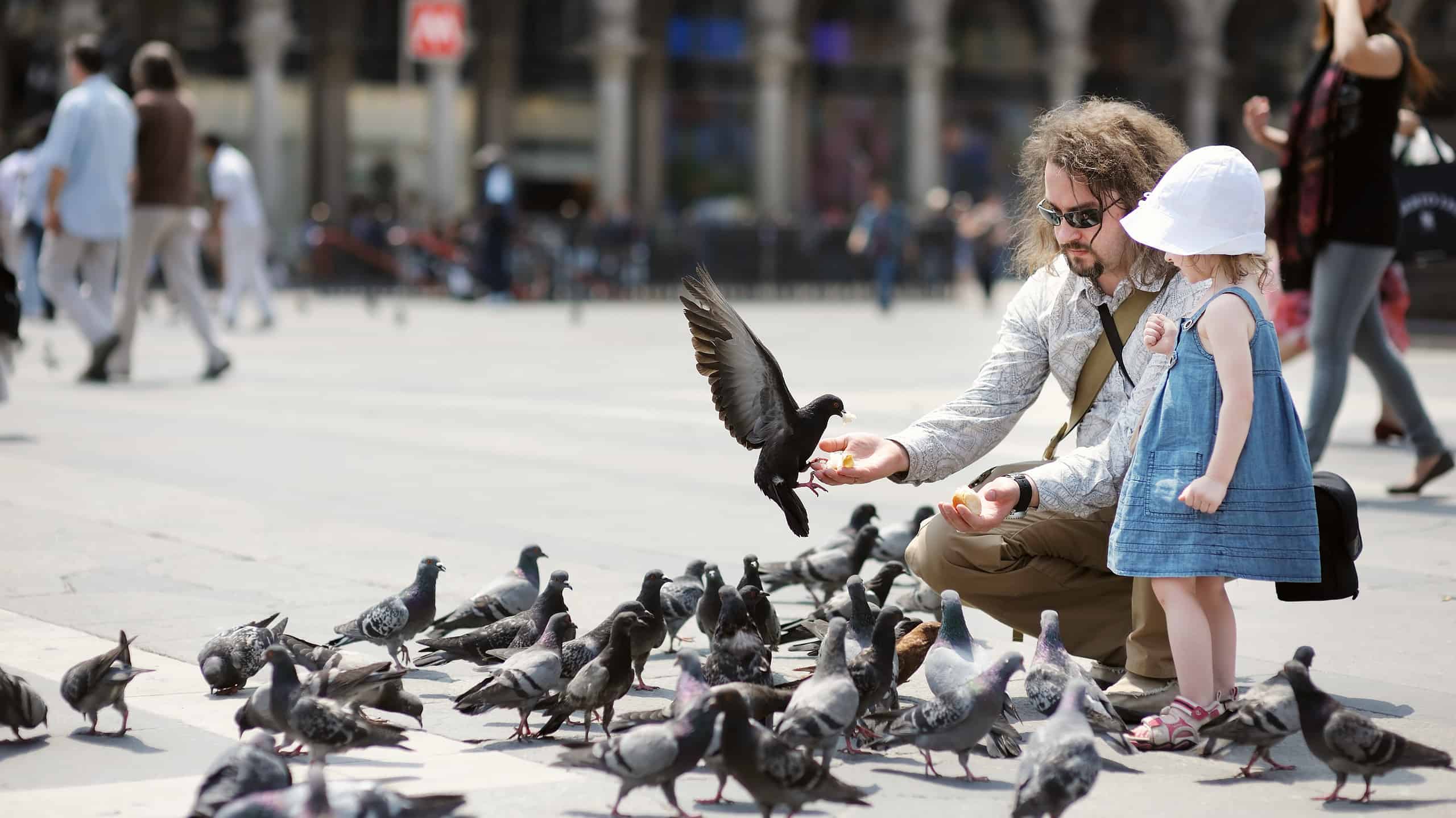Folks who live in big cities are, perhaps, most familiar of all with these winged birds with so many nicknames. Stroll through Central Park, and you’ll likely not turn a corner without seeing at least a few pigeons perched atop a statue leaving its white marks behind. You might have heard them called disparagingly rats with wings, sky rats, feathered rats, gutter birds, or even flying ashtrays, if you visit Montreal in Quebec, Canada. The common, feral pigeon is often looked down upon because of its messy habits, and just how many of them there can be in one place. But what is a big group of pigeons called?
The Short Answer: Flock

A flock of pigeons in the clear sky. Some species migrate, but many don’t.
©stockphoto mania/Shutterstock.com
Commonly, a collective of pigeons will have the common term “flock” thrust upon them. This term is typically given to any collection of birds if folks don’t know – sometimes correctly, sometimes not. In the case of pigeons, the collective term is “flock,” but it may also be any number of others.
Other Terms for Groups of Pigeons

In large cities, you’ll find many pigeons, all over the world — often in huge flocks of hundreds or even thousands of birds.
©MNStudio/Shutterstock.com
Something like 300 species of pigeons and doves (yes, they’re in the same family!) live around the world. The diversity even among pigeons is huge and many have a particular affection for specific pigeon species or pigeons in general.
A wide range of uses for pigeons have emerged over centuries as well, which may be part of where these various collective names come from.
- In pigeon breeding, a group of pigeons is known as a kit or kitte.
- A group of flying pigeons is known as a flight of pigeons.
- Tongue in cheek, some folks call them a band of pigeons.
- Those who despise the birds may call them a dropping of pigeons.
- Those who hate them may also call them a plague of pigeons.
- They may be known as a stool of pigeons (think to 1920s – a stool pigeon!).
- You might hear reference to a passel, loft, or school of pigeons from those who don’t mind them.
Do Pigeons Actually Flock Together?

Pigeons generally flock together for every season except breeding season.
©iStock.com/Nikolay Chekalin
The old adage of “birds that flock together” can definitely apply to feral pigeons. They may collect into groups of 20 birds or much larger – even into thousands of pigeons in a single colony.
Schools of pigeons will usually form outside of the breeding season. When breeding begins, though, they’ll break off into mated pairs to raise their squabs (chicks). Once winter hits, they’re back into those collectives again, roosting together to help protect themselves. The flocks may well gather in woodland or forested areas, but they also love a good, abandoned building or attic space.
It should be noted that the species of pigeon may determine how large its flock is. Victoria crowned pigeons, for example, tend towards much smaller flocks, while rock doves or rock pigeons (the common pigeons in NYC, Chicago, and other major cities) will form larger groups.
Why Do Pigeons Form Flocks?

The racing pigeon comes home and prepares for landing.
©iStock.com/Frank Cornelissen
Just as people do best in community, pigeons need other pigeons around in large numbers to help them have a better life. Primarily, large bands of pigeons will provide protection against predators for each other during the non-breeding season. Some common predators include weasels, ferrets, cats, foxes, dogs, coyotes, hawks, falcons, owls, and similar. These predators are frequently common in city dwellings as well, partially because they can find so many rodents and birds that make for easy prey.
Intriguingly, a scientific study from London showed that pigeons may provide selfless protection of each other, particularly against flying predators. They’ll band together to protect one another from such predation.
Being nonmigratory birds, pigeons also flock together for longer travel distances than merely one end of the park to the other. This relocation may occur primarily because of food sources. Of course, as with most birds, the species of pigeon will determine their habits with this. Tropical pigeons may fly from island to island, while others will roam for several hundred miles to find the next abundant food source rather than seasonal travel like migratory birds.
When Do Pigeon Bands Form?

Pigeon parents remain in the nest for several weeks to tend to their babies, known as squabs. Once the squabs are grown enough, the parents return to the flock.
©ARTFULLY PHOTOGRAPHER/Shutterstock.com
Being communal feeders for the most part, pigeons tend to flock together for most of the year. The exception is during breeding season when they’re raising the little squabs. The rest of the year, you’ll find small to massive collections of pigeons roaming parks, fields, and other locations where they can feed together.
So, if you ever felt like there was a “pigeon season” you weren’t crazy. You were probably experiencing the return of pigeon flocks after the breeding season has ended.
Are All Pigeons Non-Migratory?
While many species of pigeons, such as those found in large cities, are non-migratory birds, there are some birds in the family that do migrate. Some migratory species include the band-tailed pigeon, the turtle dove, and the wood pigeon.
When migrating, doves and pigeons most commonly fly in groups rather than solo or in pairs.
How Big Do Pigeon Flocks Get?
Depending on the species of pigeon or dove, a flock may be as small as a handful of birds to literally thousands. Common species like wood pigeons and feral pigeons and rock doves frequently collect in the hundreds or thousands.
What is a Group of Carrier Pigeons Called?

Carrier Pigeon in tow.
©iStock.com/slowmotiongli
While they’re not as common as once they were, carrier pigeons do still exist. A group of these birds is called a homing of pigeons, mainly because they are trained to “home” toward a given destination. Training for these birds involves navigational skills so that they learn how to return to their home roosts, with a range of something like 600 miles.
Thank you for reading! Have some feedback for us? Contact the AZ Animals editorial team.








